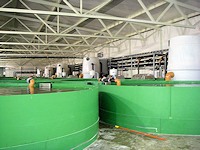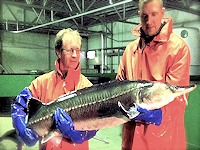Facility and equipment
Production
 First
batch of Siberian sturgeon (Acipenser baerii) were brought to
Finland in 2005 and the farming in Varkaus started in January 2007.
The fish and caviar processing unit was started in 2011 and in 2012
the farming capacity was doubled. First batches of caviar were
launched to the market in 2012.
First
batch of Siberian sturgeon (Acipenser baerii) were brought to
Finland in 2005 and the farming in Varkaus started in January 2007.
The fish and caviar processing unit was started in 2011 and in 2012
the farming capacity was doubled. First batches of caviar were
launched to the market in 2012.
The production area, all indoors, is now about 8000 sqm. There are 20 production units in the farm and each one of them has its own water recirculation system. This is different strategy than in most other recirculation farms; typically recirculation farms have a centralized cleaning system. The great advantage in this system is the risk management: in the case of technical failure only one unit is affected. The risks for technical failures in recirculation systems are much higher than in regular flow-through farms.
Water volume, supply and treatment
The water volume of each of the 20 rearing units is about 230 m3 (Figures 1 and 2). The largest tanks (13 m diam.) are always one unit each but in the new part of the farm each unit consist of four tanks of 6 m in diameter. Water depth of the tanks varies between 1.7 and 1.9 m. The filter part of each unit consists of a drum filter, fluidized bed filter and aeration tower (Figure 3). The biological part of the filtering system is designed and distributed by Arvotec Ltd., Finland.
The farm has its own flotation cleaning system for outgoing water. The sludge is directed to the factory’s water treatment system to be later burned. The cleaned water is released to the downstream side lake which is polluted because of the paper mill and municipality wastes.
Feeding
The feeding is based either on a feeding robot (Figure 4) for the large tanks in the old part (video) or on tank-wise automated feeders (Figure 2). The robot and automated feeders are made by Arvotec Ltd. Arvotec system includes also over 100 measuring points in the farm. For example oxygen, pH and temperature is measured continuously from every tank. Measuring and feeding automation is a requirement for the functionality of the system. The grow-out tanks are fed 5 to 6 times a day and the fingerlings (Figure 5) every hour. Constant feeding is important for the functionality of the bacteria during nitrification in a recirculation system. NO2 and NO3 are measured with a luminometer but they are not measured on frequent basis. Oxygen saturation in the tanks is 80-100%. There is no denitrification unit in this system.
Sex and age determination
 One of the most important equipment for running a caviar
farm is an ultrasound device for sex determination and also for
determination of egg maturity and quality. The fish are sexed at the
age of 2 years and at about 2 kg. The males are slaughtered at this
stage. The fish are tranquilized with benzocaine for handling. The
photo on the right depicts one of our Beluga sturgeons. This
beautiful female weigh now 45 kg and today's ultrasound showed that
she will be ready to deliver first-class beluga caviar in about 18
months.
One of the most important equipment for running a caviar
farm is an ultrasound device for sex determination and also for
determination of egg maturity and quality. The fish are sexed at the
age of 2 years and at about 2 kg. The males are slaughtered at this
stage. The fish are tranquilized with benzocaine for handling. The
photo on the right depicts one of our Beluga sturgeons. This
beautiful female weigh now 45 kg and today's ultrasound showed that
she will be ready to deliver first-class beluga caviar in about 18
months.
Technical equipment
There are two back-up generators for producing electricity in the case of electrical failure. So far only one of them was used briefly in 2008. However, this backup is of outmost importance for running a recirculation farm because any break in electricity would quickly induce mass loss of fish as all water movement, filtration and aeration is based on pumped water.